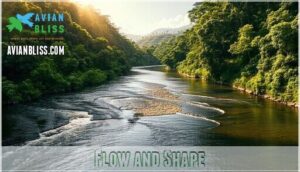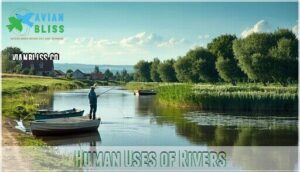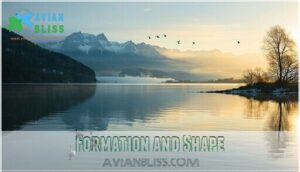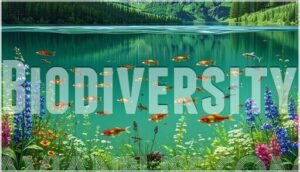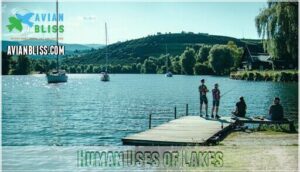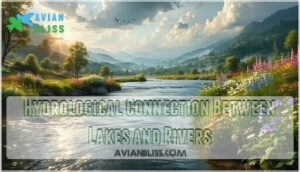This site is supported by our readers. We may earn a commission, at no cost to you, if you purchase through links.

Lakes sit quietly, collecting rain and runoff, while rivers rush along, carving valleys and carrying sediments downstream.
You might think of lakes as nature’s reservoirs and rivers as winding highways.
Both support unique ecosystems, shape landforms, and provide water for people, animals, and plants.
Whether you’re casting a fishing line or paddling a canoe, you’re tapping into centuries-old natural processes.
If you’ve ever wondered how lakes and rivers connect, or why their differences matter, you’re in the right place to learn about lakes and rivers and their unique ecosystems.
Table Of Contents
- Key Takeaways
- Definition of Lakes and Rivers
- Formation of Lakes and Rivers
- Characteristics of Rivers
- Importance of Rivers
- Human Uses of Rivers
- Characteristics of Lakes
- Importance of Lakes
- Human Uses of Lakes
- Hydrological Connection Between Lakes and Rivers
- Environmental Challenges Facing Lakes and Rivers
- Frequently Asked Questions (FAQs)
- Can rivers form from lakes?
- What is the difference between a river and a lake?
- Where are rivers and lakes found?
- Why are lakes and rivers important?
- What type of water is a lake?
- What is the difference between oceans rivers and lakes?
- What is the difference between lakes and rivers?
- What is it called where a river meets a lake?
- What are 5 interesting facts about lakes?
- What is the difference between rivers and lakes?
- Conclusion
Key Takeaways
- You’ll discover that lakes and rivers form through different geological processes – glacial carving, tectonic activity, and volcanic origin create still lake basins, while rivers constantly flow and reshape landscapes through erosion and sediment transport.
- You can rely on both water bodies for essential human needs like drinking water, irrigation, transportation, and recreation, but they require different management approaches due to their contrasting flow patterns and ecosystem characteristics.
- You’ll notice lakes and rivers support distinct but interconnected ecosystems – rivers create dynamic habitats with constant water movement that support species adapted to flow, while lakes provide stable environments with diverse depth zones and minimal currents.
- You should understand that lakes and rivers work together as connected systems in the water cycle, with rivers feeding lakes through inflows and lakes releasing water through outlets, creating a network that’s vulnerable to pollution, climate change, and overuse.
Definition of Lakes and Rivers
When you think about Water Types, lakes and rivers stand out as classic examples of freshwater habitats.
A lake is a deep, persistent standing body of water surrounded by land—think peaceful blue pools nestled in valleys.
In contrast, a river is a moving stream, always flowing between defined riverbanks, shaping landscapes as it goes.
These Water Bodies differ in their Lake Formation and River Systems, with lakes acting as reservoirs and river systems serving as nature’s drainage channels.
Their unique Geographic Features create diverse lake ecosystems and dynamic river systems.
Understanding bird habitats and ecosystems is essential for maintaining biodiversity in these freshwater environments.
Formation of Lakes and Rivers
Every lake and river you see has a story written by Earth’s restless forces.
Each bend and basin is shaped by nature’s power, leaving behind a living record of Earth’s energy.
Lake formation and river formation result from geological processes that shape freshwater habitats and influence the water cycle.
Glacial Formation carves deep lake basins as ice sheets scrape and gouge the land.
Tectonic Activity pulls apart or pushes together sections of Earth’s crust, leaving behind rift valleys and basins.
Volcanic Origin creates crater lakes when eruptions leave behind hollows that fill with water.
River Networks, always on the move, can change course and leave oxbow lakes behind.
Here’s how nature works its magic:
- Glacial Formation
- Tectonic Activity
- Volcanic Origin
- River Networks
Characteristics of Rivers
When you look at rivers, you’ll notice they constantly flow along defined banks, shaped by gravity and the terrain.
These moving bodies of water transport sediment, support diverse species, and play a pivotal role in connecting ecosystems.
Flow and Shape
Rivers never follow a straight path; instead, they twist and bend, creating mesmerizing meanders that reflect dynamic water flow and ever-changing river geometry.
Unlike lake morphology, stream dynamics shape riverbanks and channel patterns, constantly adjusting to terrain and rainfall.
You’ll notice how water movement in rivers is active, always seeking the easiest route, which is crucial for river management to guide safe navigation and protect surrounding landscapes, relying on understanding these shifting flows.
Erosion and Sediment Transport
Watching riverbanks crumble through hydraulic action, you’ll see River Erosion and Bank Collapse at work, especially during floods.
Sediment Load increases as soil and debris are swept downstream, raising Water Turbidity.
This ongoing erosion and sedimentation can lead to Soil Degradation, impacting water quality.
Managing water flow and lake restoration efforts helps reduce these effects, protecting both rivers and surrounding landscapes.
Effective conservation strategies, including habitat restoration, are essential for maintaining healthy ecosystems and biodiversity in these areas.
Flora and Fauna
When you explore river biodiversity, you’ll notice how aquatic life adapts to constant movement.
River otters dart through freshwater fish habitats, while water birds hunt along the banks.
River ecosystems differ from lake ecosystems, offering unique aquatic plants and food webs.
You’ll find:
- Aquatic plants anchoring soil and filtering water
- Freshwater fish like salmon using rivers for spawning
- Microorganisms breaking down organic matter
These features make river habitats dynamic, supporting diverse aquatic ecosystems and contributing to overall lake biodiversity with unique aquatic plants.
Importance of Rivers
From shaping valleys to supporting rich river biodiversity, rivers are the backbone of River Ecology.
You’ll find that their constant flow helps with Water Purification and Flood Control, delivering essential Ecosystem Services.
River Navigation and river management keep communities connected and safe.
Rivers regulate climate and transport nutrients, maintaining water quality for plants and animals.
River pollution can disrupt these benefits, but river restoration projects aim to repair habitats and restore balance.
Even natural riverbank erosion plays a role in keeping ecosystems healthy.
Without rivers, landscapes, wildlife, and people would lose a critical source of life and stability.
Human Uses of Rivers
You rely on rivers for transportation, irrigation, and recreation, as their constant flow makes them ideal for moving goods, supplying water to crops, and supporting activities like fishing and boating.
These uses have shaped how people build cities, manage resources, and interact with the environment throughout history.
Transportation
You mightn’t realize just how vital River Navigation and Lake Shipping are for moving goods.
Water Routes support heavy boat traffic, ferry services, and efficient transportation, saving fuel and reducing emissions.
These liquid highways connect cities, power economies, and even influence water management.
Still, increased navigation can stress ecosystems, so balancing commerce with conservation is essential for sustainable progress.
The use of river freight transport can help reduce environmental impacts while improving logistics and transportation efficiency, which is crucial for environmental conservation and supports the idea of liquid highways.
Irrigation
Rivers do more than move boats—they’re the backbone of farm irrigation and water management.
You depend on their steady flow to boost crop yield, maintain soil conservation, and support drainage systems.
Smart water resources planning means you can grow diverse crops, manage water scarcity, and guarantee efficient farm irrigation.
Here’s how rivers help:
- Water Management
- Crop Yield
- Soil Conservation
- Drainage Systems
- Farm Irrigation
Effective irrigation systems require understanding of farm irrigation systems to maximize water usage and ensure smart water resources planning.
Recreation
After irrigation, you’ll notice river recreation offers endless options.
You can kayak, try water sports, or enjoy river cruises. Anglers swap fishing tips while swimmers cool off.
Boating safety is key, especially with swift currents. River recreation connects you to aquatic habitats and highlights the importance of water conservation.
Compare activities below:
| Activity | River Recreation | Lake Recreation |
|---|---|---|
| Fishing Tips | Dynamic | Tranquil |
| Boating Safety | Essential | Important |
| Water Sports | Thrilling | Relaxed |
| River Cruises | Scenic | Leisurely |
Characteristics of Lakes
When you look at lakes, you’ll notice they’re deep, persistent bodies of water surrounded by land, with minimal water movement except for occasional wind-driven currents.
You can expect lakes to support diverse ecosystems, ranging from freshwater to brackish environments, and provide stable habitats for many aquatic species, which is a key factor in supporting aquatic species.
Formation and Shape
When you look at lakes, their formation is a story shaped by tectonic activity, glacial formation, and volcanic origin.
Lake morphology varies—some are round, others have jagged edges—based on how they formed.
Glacial erosion can carve deep basins, while tectonic shifts create depressions.
Human-made lakes add another layer to water bodies classification.
Unlike river geometry, lake formation often results in enclosed, still water bodies.
The presence of aquatic birds near lakes is influenced by bird habitat types, which is related to lake formation and aquatic birds.
Lack of Current
In lakes, water stagnation is common because there’s no steady current to stir things up.
Wind effects can mix the surface, but deeper layers often remain still, leading to stratification based on lake depth.
This slow water renewal impacts everything from lake pollution to lake management, making currents and water dynamics in these water bodies completely different from rivers’ constant movement, due to the lack of steady current.
Biodiversity
Even without strong currents, lake waters still offer a patchwork of habitats where aquatic life flourishes.
You’ll spot everything from plankton to big fish, all making use of stable, nutrient-rich waters.
Riparian zones—those overlooked shorelines—are biodiversity hotspots, sheltering unique wildlife.
Lakes’ calm conditions foster ecosystem services, habitat diversity, and boost species conservation, anchoring essential freshwater ecology.
Importance of Lakes
When you think about lakes, remember they’re more than scenic spots—they’re lifelines for entire regions.
Lakes quietly fuel communities, nurture wildlife, and anchor the balance of our natural world.
Their still waters help regulate local climates, support aquatic habitats, and act as massive water storage tanks. Lake ecosystems shape the biodiversity conservation efforts that keep our planet’s ecological balance in check.
Each lake’s unique shape influences the water cycle and the complex web of life within. Pollution can disrupt these aquatic environments, so lake management matters.
If you care about the health of freshwater systems, keep these roles in mind:
- Water Storage for communities
- Biodiversity Conservation in aquatic habitats
- Regulating local ecosystems
Human Uses of Lakes
You’ll find lakes serve a wide range of human needs, including recreation, fishing, and water supply for homes and farms.
These bodies of water are managed for tourism, aquaculture, and irrigation, with each use requiring careful planning to balance ecological health and resource demands, ensuring ecological health is maintained.
Recreation and Tourism
Ever wonder why recreation and tourism thrive around lakes?
You’ll see everything from Boating Activities and Water Sports to Lake Resorts lining the shore.
With safety as a top priority, you get to explore aquatic environments while supporting local economies.
Ecotourism encourages you to enjoy nature responsibly, while river cruises and fishing tourism connect visitors to diverse water habitats, blending fun with scientific curiosity.
River cruises and fishing tourism are part of the experience, but the main focus is on enjoying these activities in a responsible manner.
Fishing and Aquaculture
After a day spent on the water, you’ll notice fishing and aquaculture shape lake life.
Fish farming boosts aquatic biodiversity, while careful monitoring keeps water quality healthy.
Sustainable fishing supports local economies and protects aquatic life. The use of proper Fishing Gear is essential for maintaining healthy fish populations.
If you’re curious about the science behind the scenes, check out:
- Fish habitat restoration
- Eco tourism linked to lakes and rivers
- Regulations for water ecosystems
Water Supply and Irrigation
After casting your line, it’s easy to see lakes aren’t just for fishing—they’re lifelines for water supply and irrigation.
You rely on lakes for Water Management and Agricultural Sustainability, especially when rivers run low.
Here’s how they support you:
- Reservoirs boost Irrigation Systems and Crop Yield.
- Watershed management encourages Water Conservation.
- Water quality monitoring keeps your hydrologic cycle safe for everyday use.
Effective irrigation relies on advanced Irrigation Systems to optimize water distribution.
Hydrological Connection Between Lakes and Rivers
Nature’s blueprint links lakes and rivers through a constant water exchange, forming the backbone of hydrology systems.
Rivers act as lifelines, delivering nutrients and sediments via river inflows that nourish lakes, while lake outlets often become the headwaters for new rivers.
This back-and-forth is a key part of the water cycle and hydrologic cycle, supporting fish migration, water quality, and ecosystem balance.
When you think about watershed protection, remember how lakes and rivers work together—no body of water stands alone, and their connection keeps the entire system healthy, ensuring both lakes and rivers thrive for generations.
Environmental Challenges Facing Lakes and Rivers
When you look at lakes and rivers, you’ll notice they’re facing some serious environmental challenges.
The effects of water pollution, climate change, and water scarcity are reshaping these ecosystems, threatening ecological balance and watershed protection.
Here’s what you need to watch for:
- Pollution Effects: Industrial runoff, untreated sewage, and farm chemicals lower water quality, causing algal blooms and fish deaths.
- Climate Change: Warming waters and unpredictable rainfall disrupt habitats, increase floods and droughts, and speed up ecosystem disruption.
- Water Scarcity: Overuse for farming and industry drains water levels, raising pollutant concentration and harming conservation efforts.
Protecting these waters means supporting environmental conservation every step of the way.
Understanding water scarcity issues is essential for developing effective strategies to conserve lakes and rivers.
Frequently Asked Questions (FAQs)
Can rivers form from lakes?
You’ll often see rivers forming from lakes when water finds a natural outlet, flowing downhill due to gravity.
That river then carries lake water to larger rivers, seas, or oceans, acting like nature’s drainage system.
What is the difference between a river and a lake?
You’ll spot a river by its steady flow between banks, always moving toward an ocean or another river.
While a lake stays put, surrounded by land, holding water with little movement except for wind or inflows.
Where are rivers and lakes found?
Imagine tracing the veins of the planet—rivers and lakes thread through mountains, valleys, deserts, and plains.
You’ll find them almost everywhere, shaping landscapes, supporting life, and sometimes hiding in the least expected corners of the world, which is a remarkable aspect of their role in shaping our environment.
Why are lakes and rivers important?
You rely on lakes and rivers to supply drinking water, support wildlife, and grow crops.
These moving and standing waters shape land, nurture plants and animals, and help communities thrive—all while silently carrying away waste and nutrients.
They are essential for the environment, and their importance cannot be overstated, as they silently carry away waste.
What type of water is a lake?
Like a crystal-clear window into nature’s depths, you’ll find lakes contain freshwater most of the time, though some hold saltwater or brackish water depending on their location and mineral content.
What is the difference between oceans rivers and lakes?
You’ll find oceans are vast saltwater bodies covering most Earth’s surface, rivers are flowing freshwater streams moving toward larger waters, and lakes are still freshwater bodies surrounded by land.
What is the difference between lakes and rivers?
Rivers flow continuously from source to outlet, while lakes remain stationary, surrounded by land with no natural drainage, creating distinct ecosystems and water renewal patterns.
What is it called where a river meets a lake?
Over 3 million spots exist where rivers meet lakes worldwide.
You’ll encounter a river mouth or inlet at these junctions.
The flowing water creates deltas, depositing sediment as currents slow upon entering the lake’s still waters.
What are 5 interesting facts about lakes?
You’ll discover that Lake Baikal holds 20% of Earth’s fresh surface water, while nearly half of large lakes have lost ecological resilience since 2009, signaling environmental vulnerability.
What is the difference between rivers and lakes?
While lakes sit still like calm mirrors, rivers dance downstream with purpose.
You’ll notice lakes store water in basins surrounded by land, staying relatively motionless.
Rivers flow constantly, carrying water from source to sea through defined channels.
Conclusion
Surprisingly, despite their fundamental differences, lakes and rivers work together as interconnected systems that sustain Earth’s water cycle.
You’ve learned how flowing rivers carve landscapes while still lakes store precious water resources.
These contrasting water bodies support distinct ecosystems, from river rapids teeming with trout to peaceful lake depths harboring bass.
Understanding lakes and rivers helps you appreciate their essential roles in providing drinking water, supporting wildlife, and offering recreational opportunities that connect communities worldwide, which is crucial for sustaining wildlife.
- https://blogs.worldbank.org/en/transport/moving-from-roads-to-rivers--the-tremendous-potential-of-inland-
- https://transportgeography.org/contents/chapter1/emergence-of-mechanized-transportation-systems/american-canals-19th-century/
- https://www.nps.gov/miss/learn/historyculture/river-of-history-chapter-4.htm
- https://www.archwaymarinelighting.com/inland-waterway/how-inland-waterways-support-the-us-economy/
- https://www.irpt.net/economic-impact/


